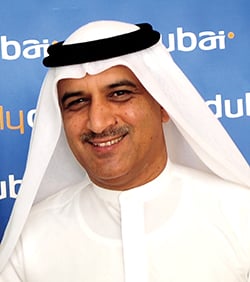
Flydubai’s all-Boeing narrowbody fleet includes 42 737 MAX 8s and three MAX 9s, with 138 MAX variants on order.
Flydubai was established in March 2008 as an LCC and grew quickly by serving secondary markets from Dubai and as a strategic partner of Emirates Airline, although it is not part of the Emirates Group. Owned by the government organization Dubai Aviation Corp., flydubai has not placed any new aircraft orders since 2017 and has an all-Boeing narrowbody fleet. But that may change as talks are ongoing with both Airbus and Boeing about the future fleet. Ghaith Al Ghaith has been CEO since flydubai’s launch in 2008, before which he was at Emirates.
– Interview by KURT HOFMANN
Are you getting the aircraft you need to align with planned capacity? Our pipeline of aircraft deliveries is something like 140 aircraft and so we still have a healthy pipeline. Like everybody else, we are affected by the supply-chain problems. At flydubai, we made a good call during the pandemic when we committed with Boeing to take more than 30 aircraft [737s] over two years. This was a good decision. Not all the aircraft we wanted came on time. In terms of aircraft deliveries, 2022 was a horrible year. This year is still bad but maybe 2024 will be better. But the supply-chain issue is not only about the aircraft; it’s also about seats, galleys, etc.

You have 30 737-800s in service. How long do you expect to keep them? Usually, we keep our aircraft for eight to 10 years and that’s the plan. With the aircraft that we own, we will try to keep them as long as we can because there is so much demand and a shortage of aircraft right now, so I don’t want to write off any aircraft. With the leased aircraft, we will renegotiate to keep them longer.
What about your future fleet plans? This is ongoing with Airbus and Boeing. As a matter of a fact, it is high time for us to make a new order in the very near future. I hope we can do something this year; I hope in time for the Dubai Air Show [in November]. It is a very open, transparent competition for us; whoever gives us the right deal, we will go for it. We really like the extra range of the [Airbus A320 family] neo. This would give us a choice of routes that we can’t serve with our current aircraft. And that is definitely a big advantage for Airbus versus Boeing. The A321XLR is not very attractive to us. But the A321LR gives us a beautiful band of expansion. I can’t tell you the exact number of possible new destinations, but it definitely gives us a handful of routes that would be a huge plus. So far, the type and number of aircraft, whether Airbus or Boeing, is still subject to many factors.
You’ve announced new “Business Suites” for your 737 MAXs. Why now? We started this project two or more years ago, when we were looking at the success of our current premium product, which has evolved over the last 10 years. The main driver for having a business-class cabin was Dubai, which is a business hub with lots of demand for business class. Our current flat-bed seat has been a big success. Looking forward, we knew we wanted to do something special. We have had a long relationship with seat manufacturer Safran. I think the new Business Suites are a genius way to align the seats so that you can see the window and have a seat with both a view and privacy. We have a plan to roll it out throughout our fleet. The Business Suites will come on the MAX 8 and will also be on the MAX 9 in the future. It will be introduced in the last quarter of 2023.
How would you define your relationship with Boeing? We have been served extremely well by Boeing and the 737, and we are working very closely with them. The MAX 10 is always an option, and we continue to look at it, but there is no decision yet on whether to take it.
Are airports and cities keen to attract flydubai? Yes, and they know they cannot ignore what is happening here in Dubai. Now we are entering a new parameter. After COVID, the influx of visitors or people who want to retire in the UAE is enormous. In the first quarter of this year, flydubai grew 50%. And we thought last year was an incredible year. So yes, flydubai wants to go to places. We are planning for that, but current demand is so good that we may have to delay launching some new destinations until next year. Our main focus and strategy, of course, is on which routes provide the best value. India, for example, would be a priority for more routes but is so limited [by traffic rights]. We are always adjusting what we do, where we go, based on what are the best routes for us. And our cooperation with Emirates is fantastic; we are up to 250 codeshare destinations now and it has really been a huge success for us.
Your biggest challenges? Right now, I’d like to have more aircraft. We have 76 aircraft in operation, plus two which are not in service at the moment. Up to 10 aircraft are expected to be delivered this year. In 2023, we will fly to 120 destinations, and we have already added 12 routes this year, with two more coming this summer.





